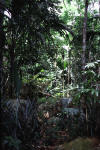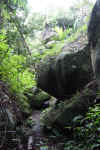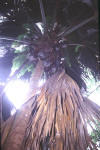|
Jardin
Marron
 For
a walk to Jardin Marron it is advisable to ask the hotel for a guide. They will
contact Ron Gerlach from NPTS, and he will not only show you the way, but during
the whole walk, he will show and explain you every plant and animal you will
meet. All together it takes about 3 and a half hours. Best is when you leave the
hotel, after crossing the bridge, to climb the rock on your right, about 30
meters after the bridge, than follow the small trail, so For
a walk to Jardin Marron it is advisable to ask the hotel for a guide. They will
contact Ron Gerlach from NPTS, and he will not only show you the way, but during
the whole walk, he will show and explain you every plant and animal you will
meet. All together it takes about 3 and a half hours. Best is when you leave the
hotel, after crossing the bridge, to climb the rock on your right, about 30
meters after the bridge, than follow the small trail, so you arrive next to the
church, this is a shortcut from 7à 800 meters. In front of the church there is
a small path leading to Jardin Marron, Mont Pot à Eau, Mont Gratte Fesse and to
Grand Barbe. You have to be careful, after crossing a small bridge, at the
split, you must take the right path, here you cross a small banana plantation,
watch at your right side the hundreds of palm spiders, and the manioc field.
From here on you are protected against the sun by the forest. Here you ‘ll see
on your right side the new water tanks to provide the village from water. A few
meters uphill you walk along several guava trees. After about half an hour walk,
the trial splits, to the left to Grand Barbe, right to Jardin Marron. This spot
is indicated with a white arrow plus the letters G B, on a big rock on your left
side. After 20 minutes more minutes, following the Jardin Marron direction, and
crossing a few rocks, you’ll see on your right side a very small pool. Except
sweet water shrimps, and lobsters, a small snail lives here, nowhere else found
in the world, not even upstream or downstream this river. As far as we know,
this is the animal with the smallest biotope in the world. The path continues
over the rock 10 meters left of the you arrive next to the
church, this is a shortcut from 7à 800 meters. In front of the church there is
a small path leading to Jardin Marron, Mont Pot à Eau, Mont Gratte Fesse and to
Grand Barbe. You have to be careful, after crossing a small bridge, at the
split, you must take the right path, here you cross a small banana plantation,
watch at your right side the hundreds of palm spiders, and the manioc field.
From here on you are protected against the sun by the forest. Here you ‘ll see
on your right side the new water tanks to provide the village from water. A few
meters uphill you walk along several guava trees. After about half an hour walk,
the trial splits, to the left to Grand Barbe, right to Jardin Marron. This spot
is indicated with a white arrow plus the letters G B, on a big rock on your left
side. After 20 minutes more minutes, following the Jardin Marron direction, and
crossing a few rocks, you’ll see on your right side a very small pool. Except
sweet water shrimps, and lobsters, a small snail lives here, nowhere else found
in the world, not even upstream or downstream this river. As far as we know,
this is the animal with the smallest biotope in the world. The path continues
over the rock 10 meters left of the
 pool. Just before arriving at Jardin Marron,
we have to climb along a sloping from about 10 meters high. (Should this rock
have given the name “gratte fesse” to the more North-laying peak?) Arriving
at Jardin Marron, we can see about 40 coco-de-mer trees Lodoicea maldivica,
planted in the forties by Henri Dauban. Now the female trees already carry their
famous nuts. To return to La Passe you have to follow the same path downhill. It
takes more than an hour to reach the hotel. pool. Just before arriving at Jardin Marron,
we have to climb along a sloping from about 10 meters high. (Should this rock
have given the name “gratte fesse” to the more North-laying peak?) Arriving
at Jardin Marron, we can see about 40 coco-de-mer trees Lodoicea maldivica,
planted in the forties by Henri Dauban. Now the female trees already carry their
famous nuts. To return to La Passe you have to follow the same path downhill. It
takes more than an hour to reach the hotel.
It
is not advisable to undertake this trip after heavy rain, because the trial
becomes a river, and you really have to walk up counter-current. It is also
dangerous when the rocks are slippery, and with the moss they really are. |
